| Elephants Temporal range: Pliocene–Present | |
|---|---|
 | |
| A female African bush elephant in Mikumi National Park, Tanzania. | |
Elephants are large mammals of the family Elephantidae and the order Proboscidea. Three species are currently recognised: the African bush elephant (Loxodonta africana), the African forest elephant (L. cyclotis), and the Asian elephant (Elephas maximus). Elephants are scattered throughout sub-Saharan Africa, South Asia, and Southeast Asia. Elephantidae is the only surviving family of the order Proboscidea; other, now extinct, members of the order include deinotheres, gomphotheres, mammoths, and mastodons.
All elephants have several distinctive features, the most notable of which is a long trunk (also called a proboscis), used for many purposes, particularly breathing, lifting water, and grasping objects. Their incisors grow into tusks, which can serve as weapons and as tools for moving objects and digging. Elephants' large ear flaps help to control their body temperature. Their pillar-like legs can carry their great weight. African elephants have larger ears and concave backs while Asian elephants have smaller ears and convex or level backs.
Elephants are herbivorous and can be found in different habitats including savannahs, forests, deserts, and marshes. They prefer to stay near water. They are considered to be keystone species due to their impact on their environments. Other animals tend to keep their distance from elephants while predators, such as lions, tigers, hyenas, and any wild dogs, usually target only young elephants (or "calves"). Elephants have a fission–fusion society in which multiple family groups come together to socialise. Females ("cows") tend to live in family groups, which can consist of one female with her calves or several related females with offspring. The groups are led by an individual known as the matriarch, often the oldest cow.
Males ("bulls") leave their family groups when they reach puberty and may live alone or with other males. Adult bulls mostly interact with family groups when looking for a mate and enter a state of increased testosterone and aggression known as musth, which helps them gain dominance and reproductive success. Calves are the centre of attention in their family groups and rely on their mothers for as long as three years. Elephants can live up to 70 years in the wild. They communicate by touch, sight, smell, and sound; elephants use infrasound, and seismic communication over long distances. Elephant intelligence has been compared with that of primates and cetaceans. They appear to have self-awareness and show empathy for dying or dead individuals of their kind.
African elephants are listed as vulnerable by the International Union for Conservation of Nature (IUCN) while the Asian elephant is classed as endangered. One of the biggest threats to elephant populations is the ivory trade, as the animals are poached for their ivory tusks. Other threats to wild elephants include habitat destruction and conflicts with local people. Elephants are used as working animals in Asia. In the past, they were used in war; today, they are often controversially put on display in zoos, or exploited for entertainment in circuses. Elephants are highly recognisable and have been featured in art, folklore, religion, literature, and popular culture.
...X
Elephants are the largest living terrestrial animals. On average, male African bush elephants are 3.20 m (10.5 ft) tall at the shoulder and mass/weigh 6,000 kg (13,200 lb), whereas females are 2.60 m (8.53 ft) tall at the shoulder and mass/weigh 3,000 kg (6,600 lb). Asian elephants are smaller, with males 2.75 m (9.02 ft) tall at the shoulder and 4,000 kg (8,800 lb) on average, and females 2.40 m (7.87 ft) tall at the shoulder and 2,700 kg (6,000 lb) on average. African forest elephants are the smallest extant species, with the average height for the species 2.00 m (6.56 ft) at the shoulder and average mass/weight 2,000 kg (4,400 lb). Male African elephants are typically 23% taller than females, whereas male Asian elephants are only around 15% taller than females.[46] The skeleton of the elephant is made up of 326–351 bones.[62] The vertebrae are connected by tight joints, which limit the backbone's flexibility. African elephants have 21 pairs of ribs, while Asian elephants have 19 or 20 pairs.[63]
An elephant's skull is resilient enough to withstand the forces generated by the leverage of the tusks and head-to-head collisions. The back of the skull is flattened and spread out, creating arches that protect the brain in every direction.[64] The skull contains air cavities (sinuses) that reduce the weight of the skull while maintaining overall strength. These cavities give the inside of the skull a honeycomb-like appearance. The cranium is particularly large and provides enough room for the attachment of muscles to support the entire head. The lower jaw is solid and heavy.[62] Because of the size of the head, the neck is relatively short to provide better support.[44] Lacking a lacrimal apparatus, the eye relies on the harderian gland to keep it moist. A durable nictitating membrane protects the eye globe. The animal's field of vision is compromised by the location and limited mobility of the eyes.[65] Elephants are considered dichromats[66] and they can see well in dim light but not in bright light.[67] The core body temperature averages 35.9 °C (96.6 °F), similar to that of a human. Like all mammals, an elephant can raise or lower its temperature a few degrees from the average in response to extreme environmental conditions.[68]
Ears
Elephant ears have thick bases with thin tips. The ear flaps, or pinnae, contain numerous blood vessels called capillaries. Warm blood flows into the capillaries, helping to release excess body heat into the environment. This occurs when the pinnae are still, and the animal can enhance the effect by flapping them. Larger ear surfaces contain more capillaries, and more heat can be released. Of all the elephants, African bush elephants live in the hottest climates, and have the largest ear flaps.[69] Elephants are capable of hearing at low frequencies and are most sensitive at 1 kHz.[70]
Trunk
The trunk, or proboscis, is a fusion of the nose and upper lip, although in early fetal life, the upper lip and trunk are separated.[44] The trunk is elongated and specialised to become the elephant's most important and versatile appendage. It contains up to 150,000 separate muscle fascicles, with no bone and little fat. These paired muscles consist of two major types: superficial (surface) and internal. The former are divided into dorsals, ventrals, and laterals while the latter are divided into transverse and radiating muscles. The muscles of the trunk connect to a bony opening in the skull. The nasal septum is composed of tiny muscle units that stretch horizontally between the nostrils. Cartilage divides the nostrils at the base.[71] As a muscular hydrostat, the trunk moves by precisely coordinated muscle contractions. The muscles work both with and against each other. A unique proboscis nerve – formed by the maxillary and facial nerves – runs along both sides of the trunk.[72]
Elephant trunks have multiple functions, including breathing, olfaction, touching, grasping, and sound production.[44] The animal's sense of smell may be four times as sensitive as that of a bloodhound.[73] The trunk's ability to make powerful twisting and coiling movements allows it to collect food, wrestle with other elephants,[74] and lift up to 350 kg (770 lb).[44] It can be used for delicate tasks, such as wiping an eye and checking an orifice,[74] and is capable of cracking a peanut shell without breaking the seed.[44] With its trunk, an elephant can reach items at heights of up to 7 m (23 ft) and dig for water under mud or sand.[74] Individuals may show lateral preference when grasping with their trunks: some prefer to twist them to the left, others to the right.[72] Elephants can suck up water both to drink and to spray on their bodies.[44] An adult Asian elephant is capable of holding 8.5 L (2.2 US gal) of water in its trunk.[71] They will also spray dust or grass on themselves.[44] When underwater, the elephant uses its trunk as a snorkel.[53]
The African elephant has two finger-like extensions at the tip of the trunk that allow it to grasp and bring food to its mouth. The Asian elephant has only one, and relies more on wrapping around a food item and squeezing it into its mouth.[10] Asian elephants have more muscle coordination and can perform more complex tasks.[71] Losing the trunk would be detrimental to an elephant's survival,[44] although in rare cases, individuals have survived with shortened ones. One elephant has been observed to graze by kneeling on its front legs, raising on its hind legs and taking in grass with its lips.[71] Floppy trunk syndrome is a condition of trunk paralysis in African bush elephants caused by the degradation of the peripheral nerves and muscles beginning at the tip.[75]
Teeth
Elephants usually have 26 teeth: the incisors, known as the tusks, 12 deciduouspremolars, and 12 molars. Unlike most mammals, which grow baby teeth and then replace them with a single permanent set of adult teeth, elephants are polyphyodonts that have cycles of tooth rotation throughout their lives. The chewing teeth are replaced six times in a typical elephant's lifetime. Teeth are not replaced by new ones emerging from the jaws vertically as in most mammals. Instead, new teeth grow in at the back of the mouth and move forward to push out the old ones. The first chewing tooth on each side of the jaw falls out when the elephant is two to three years old. The second set of chewing teeth falls out at four to six years old. The third set falls out at 9–15 years of age, and set four lasts until 18–28 years of age. The fifth set of teeth falls out at the early 40s. The sixth (and usually final) set must last the elephant the rest of its life. Elephant teeth have loop-shaped dental ridges, which are thicker and more diamond-shaped in African elephants.[76]
Tusks
The tusks of an elephant are modified second incisors in the upper jaw. They replace deciduous milk teeth at 6–12 months of age and grow continuously at about 17 cm (7 in) a year. A newly developed tusk has a smooth enamel cap that eventually wears off. The dentine is known as ivory and its cross-section consists of crisscrossing line patterns, known as "engine turning", which create diamond-shaped areas. As a piece of living tissue, a tusk is relatively soft; it is as hard as the mineral calcite. Much of the tusk can be seen outside; the rest is in a socket in the skull. At least one-third of the tusk contains the pulp and some have nerves stretching to the tip. Thus it would be difficult to remove it without harming the animal. When removed, ivory begins to dry up and crack if not kept cool and moist. Tusks serve multiple purposes. They are used for digging for water, salt, and roots; debarking or marking trees; and for moving trees and branches when clearing a path. When fighting, they are used to attack and defend, and to protect the trunk.[77]
Like humans, who are typically right- or left-handed, elephants are usually right- or left-tusked. The dominant tusk, called the master tusk, is generally more worn down, as it is shorter with a rounder tip. For the African elephants, tusks are present in both males and females, and are around the same length in both sexes, reaching up to 3 m (10 ft),[77] but those of males tend to be thicker.[78] In earlier times, elephant tusks weighing over 200 pounds (more than 90 kg) were not uncommon, though it is rare today to see any over 100 pounds (45 kg).[79]
In the Asian species, only the males have large tusks. Female Asians have very small tusks, or none at all.[77] Tuskless males exist and are particularly common among Sri Lankan elephants.[80] Asian males can have tusks as long as Africans', but they are usually slimmer and lighter; the largest recorded was 3.02 m (10 ft) long and weighed 39 kg (86 lb). Hunting for elephant ivory in Africa[81] and Asia[82] has led to natural selection for shorter tusks[83][84] and tusklessness.[85][86]
Skin
An elephant's skin is generally very tough, at 2.5 cm (1 in) thick on the back and parts of the head. The skin around the mouth, anus, and inside of the ear is considerably thinner. Elephants typically have grey skin, but African elephants look brown or reddish after wallowing in coloured mud. Asian elephants have some patches of depigmentation, particularly on the forehead and ears and the areas around them. Calves have brownish or reddish hair, especially on the head and back. As elephants mature, their hair darkens and becomes sparser, but dense concentrations of hair and bristles remain on the end of the tail as well as the chin, genitals and the areas around the eyes and ear openings. Normally the skin of an Asian elephant is covered with more hair than its African counterpart.[87]
An elephant uses mud as a sunscreen, protecting its skin from ultraviolet light. Although tough, an elephant's skin is very sensitive. Without regular mud baths to protect it from burning, insect bites and moisture loss, an elephant's skin suffers serious damage. After bathing, the elephant will usually use its trunk to blow dust onto its body and this dries into a protective crust. Elephants have difficulty releasing heat through the skin because of their low surface-area-to-volume ratio, which is many times smaller than that of a human. They have even been observed lifting up their legs, presumably in an effort to expose their soles to the air.[87]
...
Social organisation
Female elephants spend their entire lives in tight-knit matrilineal family groups, some of which are made up of more than ten members, including three pairs of mothers with offspring, and are led by the matriarch which is often the eldest female.[116] She remains leader of the group until death[112] or if she no longer has the energy for the role;[117] a study on zoo elephants showed that when the matriarch died, the levels of faecal corticosterone ('stress hormone') dramatically increased in the surviving elephants.[118]When her tenure is over, the matriarch's eldest daughter takes her place; this occurs even if her sister is present.[112] The older matriarchs tend to be more effective decision-makers.[119]
The social circle of the female elephant does not necessarily end with the small family unit. In the case of elephants in Amboseli National Park, Kenya, a female's life involves interaction with other families, clans, and subpopulations. Families may associate and bond with each other, forming what are known as bond groups. These are typically made of two family groups,[116] which may be closely related due to previously being part of the same family group which split after becoming too large for the available resources.[120]During the dry season, elephant families may cluster together and form another level of social organisation known as the clan. Groups within these clans do not form strong bonds, but they defend their dry-season ranges against other clans. There are typically nine groups in a clan. The Amboseli elephant population is further divided into the "central" and "peripheral" subpopulations.[116]
Some elephant populations in India and Sri Lanka have similar basic social organisations. There appear to be cohesive family units and loose aggregations. They have been observed to have "nursing units" and "juvenile-care units". In southern India, elephant populations may contain family groups, bond groups and possibly clans. Family groups tend to be small, consisting of one or two adult females and their offspring. A group containing more than two adult females plus offspring is known as a "joint family". Malay elephant populations have even smaller family units, and do not have any social organisation higher than a family or bond group. Groups of African forest elephants typically consist of one adult female with one to three offspring. These groups appear to interact with each other, especially at forest clearings.[116]
The social life of the adult male is very different. As he matures, a male spends more time at the edge of his group and associates with outside males or even other families. At Amboseli, young males spend over 80% of their time away from their families when they are 14–15. When males permanently leave, they either live alone or with other males. The former is typical of bulls in dense forests. Asian males are usually solitary, but occasionally form groups of two or more individuals; the largest consisted of seven bulls. Larger bull groups consisting of over 10 members occur only among African bush elephants, the largest of which numbered up to 144 individuals.[121] These elephants can be quite sociable when not competing for dominance or mates, and will form long-term relationships.[122] A dominance hierarchy exists among males, whether they range socially or solitarily. Dominance depends on the age, size and sexual condition,[121] and when in groups, males follow the lead of the dominant bull. Young bulls may seek out the company and leadership of older, more experienced males,[122] whose presence appears to control their aggression and prevent them from exhibiting "deviant" behaviour.[123] Adult males and females come together for reproduction. Bulls associate with family groups if an oestrous cow is present.[121]
...X
Communication
Touching is an important form of communication among elephants. Individuals greet each other by stroking or wrapping their trunks; the latter also occurs during mild competition. Older elephants use trunk-slaps, kicks, and shoves to discipline younger ones. Individuals of any age and sex will touch each other's mouths, temporal glands, and genitals, particularly during meetings or when excited. This allows individuals to pick up chemical cues. Touching is especially important for mother–calf communication. When moving, elephant mothers will touch their calves with their trunks or feet when side-by-side or with their tails if the calf is behind them. If a calf wants to rest, it will press against its mother's front legs and when it wants to suckle, it will touch her breast or leg.[147]
Visual displays mostly occur in agonistic situations. Elephants will try to appear more threatening by raising their heads and spreading their ears. They may add to the display by shaking their heads and snapping their ears, as well as throwing dust and vegetation. They are usually bluffing when performing these actions. Excited elephants may raise their trunks. Submissive ones will lower their heads and trunks, as well as flatten their ears against their necks, while those that accept a challenge will position their ears in a V shape.[148]
Elephants produce several sounds, usually through the larynx, though some may be modified by the trunk.[149] Perhaps the most well known call is the trumpet which is made by blowing through the trunk. Trumpeting is made during excitement, distress or aggression.[136][149] Fighting elephants may roar or squeal, and wounded ones may bellow.[150] Rumbles are produced during mild arousal[151] and some appear to be infrasonic.[152] Infrasonic calls are important, particularly for long-distance communication,[149] in both Asian and African elephants. For Asian elephants, these calls have a frequency of 14–24 Hz, with sound pressure levels of 85–90 dB and last 10–15 seconds.[152] For African elephants, calls range from 15–35 Hz with sound pressure levels as high as 117 dB, allowing communication for many kilometres, with a possible maximum range of around 10 km (6 mi).[153]
At Amboseli, several different infrasonic calls have been identified. A greeting rumble is emitted by members of a family group after having been separated for several hours. Contact calls are soft, unmodulated sounds made by individuals that have been separated from their group and may be responded to with a "contact answer" call that starts out loud, but becomes softer. A "let's go" soft rumble is emitted by the matriarch to signal to the other herd members that it is time to move to another spot. Bulls in musth emit a distinctive, low-frequency pulsated rumble nicknamed the "motorcycle". Musth rumbles may be answered by the "female chorus", a low-frequency, modulated chorus produced by several cows. A loud postcopulatory call may be made by an oestrous cow after mating. When a cow has mated, her family may produce calls of excitement known as the "mating pandemonium".[151]
Elephants are known to communicate with seismics, vibrations produced by impacts on the earth's surface or acoustical waves that travel through it. They appear to rely on their leg and shoulder bones to transmit the signals to the middle ear. When detecting seismic signals, the animals lean forward and put more weight on their larger front feet; this is known as the "freezing behaviour". Elephants possess several adaptations suited for seismic communication. The cushion pads of the feet contain cartilaginous nodes and have similarities to the acoustic fat found in marine mammals like toothed whalesand sirenians. A unique sphincter-like muscle around the ear canal constricts the passageway, thereby dampening acoustic signals and allowing the animal to hear more seismic signals.[154] Elephants appear to use seismics for a number of purposes. An individual running or mock charging can create seismic signals that can be heard at great distances.[155]When detecting the seismics of an alarm call signalling danger from predators, elephants enter a defensive posture and family groups will pack together. Seismic waveforms produced by locomotion appear to travel distances of up to 32 km (20 mi) while those from vocalisations travel 16 km (10 mi).[156]
Intelligence and cognition
Elephants exhibit mirror self-recognition, an indication of self-awareness and cognitionthat has also been demonstrated in some apes and dolphins.[157] One study of a captive female Asian elephant suggested the animal was capable of learning and distinguishing between several visual and some acoustic discrimination pairs. This individual was even able to score a high accuracy rating when re-tested with the same visual pairs a year later.[158] Elephants are among the species known to use tools. An Asian elephant has been observed modifying branches and using them as flyswatters.[159] Tool modification by these animals is not as advanced as that of chimpanzees. Elephants are popularly thought of as having an excellent memory. This could have a factual basis; they possibly have cognitive maps to allow them to remember large-scale spaces over long periods of time. Individuals appear to be able to keep track of the current location of their family members.[67]
Scientists debate the extent to which elephants feel emotion. They appear to show interest in the bones of their own kind, regardless of whether they are related.[160] As with chimps and dolphins, a dying or dead elephant may elicit attention and aid from others, including those from other groups. This has been interpreted as expressing "concern";[161] however, others would dispute such an interpretation as being anthropomorphic;[162][163] the Oxford Companion to Animal Behaviour (1987) advised that "one is well advised to study the behaviour rather than attempting to get at any underlying emotion".[164]
Click to read article


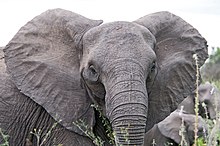
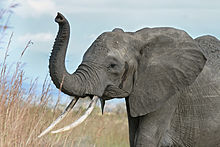
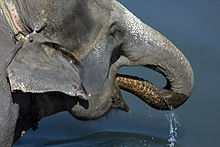

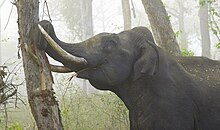


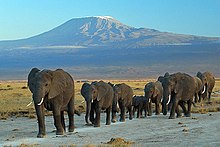

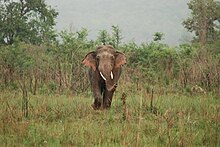



No comments:
Post a Comment